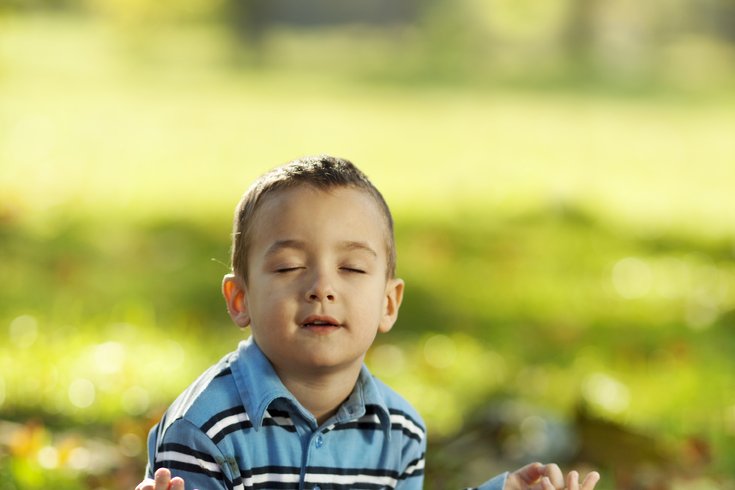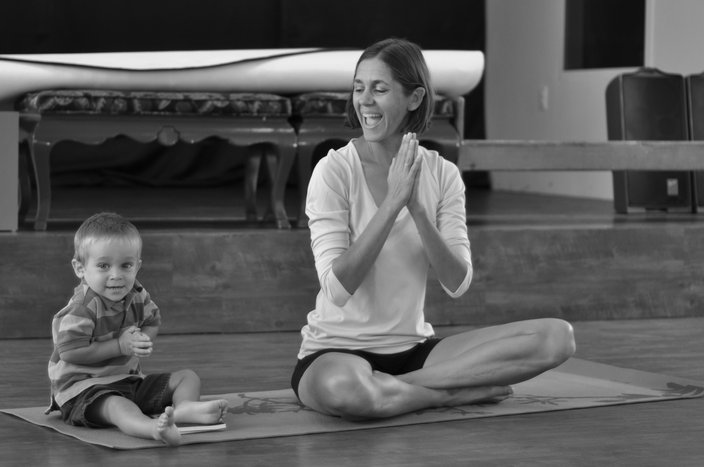
September 08, 2015
 File Art/for PhillyVoice
File Art/for PhillyVoice
There are many reasons why integrating meditation and mindfulness practices into family life is a good idea
"Meditation helps your body feel good.”
-- Taber, 3 1/2
It’s hard to imagine my life without a 20-minute pause in the middle of the day. As my son naps, I sit up tall, close my eyes and gently bring attention to the ebb and flow of breath. No matter what is going on, I can uncover insight and find rest for a joyful or troubled heart while opening to the comforting presence of peace.
As a long-time meditator, the practice of cultivating a calm inner state is woven into my experience of living. There were years when I sat in silence for hours a day. Today, as a mother of a lively 3 1/2-year-old, 20 minutes works wonders.
Like cooking, exercising, reading, or going for a walk, meditation is simply something I do. It positively impacts not only my overall well-being but also reminds me of truths I hold dear. For example, I’ve lived and traveled a great deal both in the U.S. and abroad. When I close my eyes in silence, I am reminded of my true home.
Gratefully, my husband is also committed to living mindfully and integrating moments of quiet into the rhythms of his life. Nature is his teacher of choice and spending time in solitude outdoors is central to his well-being.
However, it’s one thing to maintain a personal meditation practice or take a weekend to go camping alone; it’s quite another to integrate mindfulness and meditation into the rhythms of a shared family life. My husband may go for a long walk in the woods. I may sit in silence. The insight cultivated certainly impacts our son, but what about the crafting of shared mindfulness activities? What about meditating as a family?
Modern parenting is too often an exceptionally busy and isolating endeavor. Collectively, we are inundated with screens and it’s tempting to tune a distracted or distressed child into an iPad rather than teach him or her about the benefits of taking a deep breath. Even small children are too often overscheduled, stressed and increasingly medicated for behaviors a healthy and balanced lifestyle could ameliorate, if not alleviate.
It may feel overwhelming to add yet another item to the “to-do” list, especially on days when getting a child to brush her teeth feels like a small victory.
Nonetheless, there are many reasons why integrating meditation and mindfulness practices into family life is a good idea. Through mindful living, parents model self-awareness, emotional intelligence and peace in an increasingly distracting, chaotic and busy world. Whether one is dealing with difficult feelings or cultivating the quality of gratitude, meditating as a family benefits all. Luckily, these benefits can come through simple shifts in attitudes and daily rhythms.
Consider these three tips on introducing children to meditation and mindfulness.
1. Create an environment conducive to well-being, reflection and calm.
For many, the background noise of television is a constant presence in the home. And many of us compulsively check our phones for email, texts or Facebook messages. Learning how to mindfully notice thoughts, feelings and physical sensations is challenging in an environment inundated with excessive noise and constant distraction. Attention is directed outward and the not-so-subtle messages of our consumer culture are easily absorbed. Unhappy? Buy more products. Dissatisfied? Go shopping. Lonely? Check Facebook.
Contemporary research on happiness clearly reveals that outside of securing the basic needs of safety, food and shelter, the acquisition of wealth and material objects doesn’t increase our experience of well-being. An increase in screen time is also correlated with an increase in emotional problems and depression in children.
What does work?
A great deal of research highlights how the conscious cultivation of gratitude, mindfulness and the formal practice of meditation correspond to reported decreases of anxiety and depression and increases in overall well-being, not only for adults but also for children.
Crafting a home environment conducive to mindfulness and meditation involves turning off distracting noise and putting the phone down, at least for a few hours. Consider replacing the constant drone of television programming with classical or relaxing music. Or, simply appreciate the silence. Close the laptop and engage children in focusing on activities like imaginative play, puzzles, coloring or reading.
Better yet, get outside. Even a short walk in nature is proven to boost well-being. Pausing a great deal on the way to examine rocks, bugs, trees, and clouds helps children notice and appreciate the beauty of the world. Going for a walk after a rainfall? Take the opportunity to teach your child to take a deep, appreciative breath.
As parents, we create the foundational home environment molding our children’s growth and development. It’s a heady responsibility. Cultivating a peaceful and focused setting that is conducive to noticing the inner world, breath awareness and moments of calm is the first step in introducing one’s family to the benefits of mindfulness and meditation.
2. Model mindfulness and acceptance of emotion, especially difficult emotion.
“I don’t want to meditate,” my friend Jesse once told me. “I don’t want to close my eyes and feel what is there.”
I understood. I really did. There was a point in my meditation practice where great reservoirs of sadness moved through the silence. Gratefully, I received wisdom from a mentor, also a meditator, who offered needed counsel.
“The tears are the ice melting,” he told me. “Don’t be afraid.”
So, I let rivers flow. I didn’t need to know why there was so much sadness. I didn’t try to analyze it. In the silence, I just held space for grief and loss to move through my body and for tears to flow down my cheeks. Today, as a meditation teacher, I empathize with students who fear the silence because they fear feeling what is buried in it.
As parents, we hope our children don’t grow up harboring icebergs of frozen feelings in need of integration. To safeguard them from such a fate, it’s essential to model acceptance and mindfulness of emotion, especially difficult emotion.
“Humans are feeling machines,” Susan Stiffelman, author of “Parenting with Presence: Practices for Raising Conscious, Confident, Caring Kids,” told PhillyVoice.
She believes we all receive messages about “how to feel about feelings.” Messages such as: “tone it down,” “use your inside voice,” “don’t be mad,” “big boys/girls don’t cry,” etc. form templates for how children learn to process and express normal human emotion. If parents don’t become aware of their own inner templates, unconscious emotional patterns are passed on as they respond to their own children’s feelings.
“All of this has its roots many generations back,” Stiffelman contends.
For example, some families are so repressed emotionally that “no one cries at grandma’s funeral.” Other families are so expressive and quick to anger that “everyone yells at each other nearly all the time.” To change repressive or abusive emotional templates -- and cultivate healthy ones -- is challenging work. Mindfulness of such patterns is the first step.
As emotions unfold, parents can model what it is like to mindfully name and normalize feelings. In doing so, we make room for a healthy expression of both joy and sorrow.
“I see you laughing; I love sharing this happy moment with you!”
“Mommy is upset right now. I am going to go in the other room and take a few deep breaths.”
“You are crying. That’s all right. Crying helps the body get the sadness out so you can feel better again.”
Responding with gentle, gracious and expansive energy when confronting the messiness and discomfort of human life frees families from harmful templates. Cultivating a mindful and accepting attitude with regard to our emotional lives is also a hallmark of meditation practice.
3. Integrate meditation and mindfulness rituals into daily life.
A simple, white candle sits on our kitchen table. While there are occasions of forgetfulness, my husband and I do our best to light it at the beginning of every meal. We sing:
Rise up, O flame
By thy light glowing
Bring to us beauty, vision and joy.
I love it when our young son sings with us. His little voice expressed with confidence fills my heart with joy. There are times when he doesn’t join in. Perhaps he’s ornery and needs to eat right away. That’s fine; he’s young. It’s enough for him to notice the ritual, to notice that we pause before we eat to sing and sit for a moment in grateful silence.
Mealtime, naptime, bedtime – these transition moments are primed perfectly for the integration of mindfulness and meditative practices. For religious families, consider pausing for a few silent mindful breaths post-prayer. For secular families, consider making a “gratitude list” at the conclusion of the day while tucking children into bed. For families with older children, setting aside one evening a week for a special meal, the telling of family stories and 10 minutes of silent meditation can be very healing.
Please note, one doesn’t need elaborate rituals or lengthy discourses on the benefits of mindfulness. In fact, simple and repetitive practices that are seamlessly woven into the normal flow of daily life are best. Consistency is key. As American author James Baldwin once noted, “Children have never been very good at listening to their elders, but they have never failed to imitate them.”
Not long ago, my son woke up during a nap and watched me meditate. Somehow I sensed this and gently opened my eyes.
“What are you doing, mama?”
“Meditating,” I replied. “I close my eyes, focus on my breath and relax my body.” I then returned to the practice.
It was quiet for quite awhile. I decided to glance his way. In doing so, I noticed his little body sitting up tall, eyes softly closed. Then he said, “Mama, I meditate too!”
Yes.
While it’s important to nurture one’s personal practice, as parents we have much to gain by integrating mindfulness and meditation into family life. One need not be a long-time meditator to benefit from the suggestions above. In fact, learning how to practice mindfulness and meditation alongside one’s child is a wonderful opportunity.
By cultivating a home environment conducive to calm, well-being and reflection, making space for healthy emotional expression and integrating simple rituals into family life, meditation and mindfulness offer more than best practices for healthy living. Mindful and meditative practices deeply influence the templates our children inherit, crafting their responses to stress, joy and sorrow. May we forge these templates wisely.
Follow Amy on Twitter: @amywrightglenn
Add Amy’s RSS Feed: Amy Wright Glenn
